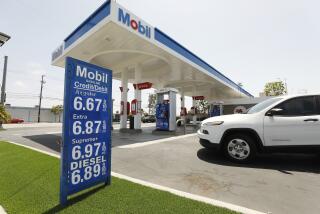Reasons for Gas Price Surge Vary
- Share via
When crude oil prices fell precipitously in early spring, gasoline prices did not. At the time, oil companies blamed rising demand and tight refining capacity, adding that changes in gasoline prices generally lag changes in crude prices by about 30 to 45 days.
But when crude oil prices skyrocketed late last week in the aftermath of the Iraqi invasion of Kuwait, gasoline prices rose within a day despite assurances from oil companies that there remained ample stocks of crude oil that had been purchased at low prices.
What’s going on?
Consumer groups and some politicians are crying foul, accusing oil companies of price gouging and profiteering, invoking the specter of past price hikes after the Iran-Iraq war in 1979 and the Exxon Valdez oil spill last year. The increases threaten to stoke inflation and would likely place a heavy burden on low-income people for whom gasoline costs are a big family budget item.
Oil companies “are not going by the amount of oil available. They are raising prices because they see prices going up in the spot market,” Ed Rothschild, spokesman for the consumer group Citizens-Labor Energy Coalition, said in the wake of Friday’s higher prices at the pump. “They are cashing in on an opportunity, but this is nothing new.”
For their part, oil companies argue that they are simply passing on the higher new costs of oil and have no intention of exploiting a volatile situation.
“There has been a steady increase in the price of crude oil over the last two months,” said Thomas Burns, manager of economics at Chevron Corp., which raised its wholesale gasoline prices by 5 cents a gallon Friday. “That is ultimately reflected in gasoline markets one way or another.”
The real reasons for the price hikes seem to lie somewhere in between the two sides, according to analysts and economists who have studied previous price swings.
“It’s almost entirely the result of structural changes in the oil market,” said Philip K. Verleger Jr., a visiting fellow at the Institute of International Economics in Washington.
Among the reasons cited for the quick price hikes are an effort to dampen demand and preserve inventories in anticipation of higher crude oil prices and potential shortages; industry practices that will have refiners paying higher crude oil prices almost immediately, even for oil ordered months ago; and transactions in the futures market that may require refiners to come up with extra cash quickly.
Of course, oil companies also see the potential to earn higher profits.
During the late spring and early summer, when crude prices fell, gasoline prices remained high. At the time, oil companies blamed that lag on tight refining capacity, high demand and natural market delays.
But refining profit margins rose to record levels during that period, analysts said.
The profitability of a barrel of refined product peaked at $11 at that time, compared with a typical refining spread of about $4, said Bernard J. Picchi, an industry analyst with Salomon Bros., an investment firm in New York.
The spread represents the difference between the wholesale price of a barrel of refined products and the cost of a barrel of crude from which those products are made.
On Friday, retail prices of gasoline had jumped by 4 cents to 14 cents per gallon around the country. On the wholesale level, refiners had raised their prices between 5 cents and 10 cents per gallon.
September contracts for West Texas Intermediate, the benchmark U.S. grade of crude oil, have gained $4.45 a barrel since Monday and $2.95 since the invasion. On Friday, the contracts closed up $1.38 to $24.49 a barrel. On the spot market, crude oil prices jumped $1.25 to close at $24.40 on Friday.
Some economists drew parallels with the sharp hike in gasoline prices immediately following the massive oil spill in Alaska’s Prince William Sound from the Exxon Valdez oil tanker in March, 1989.
In the weeks after that spill, which closed the Valdez, Alaska, marine terminal for a time and threatened to crimp West Coast supplies of Alaskan crude oil, wholesale gasoline prices jumped between 10 cents and more than 70 cents per gallon.
Much of that hike was attributed to fears of a cutoff, although no real shortages developed. Wholesalers and distributors bought up available stocks of gasoline rapidly, leading to a sharp price hike.
Some of the increases were also attributed to a simple desire by refiners to maximize profits while they could after a period of slim profit margins. As one retailer put it at the time, they didn’t want to sell a gallon of gasoline one day that they might be able to sell for a higher price a week later.
Some of the same dynamics are at work now. Fear and uncertainty about the Middle East situation has led refiners to raise prices in anticipation of demand from buyers wanting to hoard gasoline stocks in fears of a shortage, although there is no sign that has happened.
The argument is that price increases, while unpleasant and frustrating, nevertheless restrict demand and discourage hoarding that would exacerbate any real shortage of gasoline.
Refiners are also raising prices to cover the expected costs of future barrels of oil, which analysts expect to remain high. “When companies set prices, they attempt to read what the correct market price will be” down the road a bit, Chevron’s Burns said.
But last week’s price hikes also reflected real changes in oil markets, analysts said. Crude prices have been rising steadily since June, but gasoline prices have not kept pace, oil company officials argue.
On June 21, spot prices for West Texas Intermediate crude oil hit $15.30 a barrel, and wholesale spot prices for unleaded gasoline were 62 cents per gallon in New York, 60 cents per gallon on the Gulf Coast and 85 cents in Los Angeles, Verleger said.
By last Thursday, crude prices had shot up to $23.30, but wholesale unleaded gasoline prices had only crept up to 69 cents a gallon in New York and 67 cents on the Gulf Coast, and had actually fallen in Los Angeles to 81 cents.
At the same time, demand for gasoline products on the West Coast has remained strong, while inventories of gasoline have been falling because of tight refining capacity. Although refineries have been running flat out, a string of accidents and shutdowns for routine maintenance has limited refinery capacity this year.
In June, the Exxon refinery in the San Francisco Bay Area city of Benicia caught fire, halting some gasoline production. In July, a massive explosion idled an ARCO Chemical Co. petrochemical plant in Houston, which made a key gasoline component.
What about the abundant inventories of crude oil that were bought at cheap prices? Companies are reluctant to draw down supplies too rapidly, given expected shortages and higher prices, analysts argue. Unlike the Valdez spill, the current Middle East turmoil promises to have longer-term effects.
“The industry is very reluctant to liquidate its inventory as a source of supply because it is cheap crude and they don’t know how long this thing will continue,” said Jack Aydin, an oil analyst with the investment firm of McDonald & Co. in New York. “They sit on the inventories to reduce their risk, not knowing what’s going to happen down the road.”
“To the extent that oil companies have crude oil physically in inventory, the Iraqis have effectively increased the value of that crude over the last few days,” added Michael Doyle, a market analyst with Computer Petroleum Corp., a research firm in St. Paul, Minn.
Peculiarities of oil company accounting practices also ensure that price hikes in the crude oil market find their way quickly to the gasoline pump, Verleger said.
Crude oil ordered from the Middle East a month ago was contracted but not paid for. It will be paid for at the prevailing price when it arrives in U.S. ports. So an increase in the world market price translates into an instantaneous increase in the cost of crude already on order, he said.
In addition, oil companies now hedge their investments in crude oil. Crude oil inventories in company tanks are hedged by futures contracts. If crude oil prices fall, the value of the physical crude stocks may also fall, but the value of the crude futures contracts rises, offsetting the loss.
But when crude prices rise, as they are doing now, the value of the physical crude stocks may rise, but the company loses money on the futures contracts. To cover those losses, the companies need to come up with hard cash and therefore feel the need to raise wholesale product prices.
Meanwhile, the profitability of marketers--service stations and bulk distributors--remained tight through the summer as they tried to keep retail prices stable. With refiners raising wholesale prices, many retailers now feel they have no choice but to raise prices. The impact of price increases on Californians was heightened by the onset of the 5-cent-per-gallon increase in the state gasoline tax last Wednesday.
Whatever the reason for the price hikes, no one expects them to fall again nearly as fast as they rose.
“When prices go up substantially, marketers tend to pass through those increases as quickly as possible,” said McDonald J. Beavers, president of Whitney Leigh Corp., a Tulsa, Okla., market research firm. “But when prices go down, (retailers reduce) them in smaller increments, looking over their shoulders at what the other guy is doing.”
More to Read
Inside the business of entertainment
The Wide Shot brings you news, analysis and insights on everything from streaming wars to production — and what it all means for the future.
You may occasionally receive promotional content from the Los Angeles Times.










